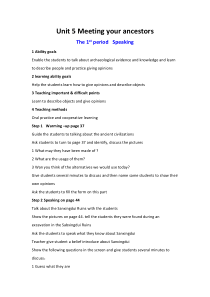 DOC
DOC
【文档说明】人教版选修八:Unit5Meetingyourancestors全单元.docx,共(9)页,20.180 KB,由envi的店铺上传
转载请保留链接:https://www.doc5u.com/view-9c95c527e97bcce6aed2111a3e998104.html
以下为本文档部分文字说明:
Unit5MeetingyourancestorsThe1stperiodSpeaking1AbilitygoalsEnablethestudentstotalkaboutarchaeologicalevidenceandknowledgeandlearntodescribepeopleandp
racticegivingopinions2learningabilitygoalsHelpthestudentslearnhowtogiveopinionsanddescribeobjects3Teachingimpo
rtant&difficultpointsLearntodescribeobjectsandgiveopinions4TeachingmethodsOralpracticeandcooperativelearningStep1Warming–uppage37Guide
thestudentstotalkingabouttheancientcivilizationsAskstudentstoturntopage37andidentify,discussthepictures1Whatmaytheyhavebeenmadeof?2What
aretheusageofthem?3Wanyouthinkofthealternativeswewouldusetoday?Givestudentsseveralminutestodiscussandthennamesamestudentstoshowtheirownop
inionsAskthestudentstofilltheformonthispartStep2Speakingonpage44TalkabouttheSanxingduiRuinswiththestudentsShowthepicturesonpage44.tellthestudent
stheywerefoundduringanexcavationintheSabxingduiRuinsAskthestudentstospeakwhattheyknowaboutSanxingduiTeachergivestudentabe
liefintroduceaboutSanxingduiShowthefollowingquestionsinthescreenandgivestudentsseveralminutestodiscuss:1Guesswhatth
eyare2Discusswhatthisobjectsareusedfor3Discusstheseobjects,youshouldincludeAThenameofthesitewherethefourobjectswerefoundandtheirpossibledatesB
Adescriptionofeachincludingappearance,shapeandguessaboutthematerialitwasmaseofCWhatwecanlearnformthe
reobjectsaboutthepeoplewholivedthen.Step3Dealwithspeakingtaskonpage84Turntopage84,readtheinstructionsanddiscussthe
paintingandfillinthePart1.Thengoonwithpart2.askthestudentstoshowtheirconclusionafterdiscussionStep4Homework
AskthestudentstofindoutsomeinformationaboutZhoukoudianCavesandPekingPersonPreviewthereadingThe2nd-3rdperio
dReading(1)1AbilitygoalsEnablethestudentstotalkaboutthedifferencesbetweenmodernpeopleandPekingLearnhowPekingmanlivedtheirlives2learning
abilitygoalsHelpthestudentslearnhowthedifferencesbetweenmodernpeopleandPeking3Teachingimportant&difficultpointsTalkaboutPekingpeopleonZhouk
oudian4TeachingmethodsListening,readinganddiscussionStep1ReviewCheckthehomeworkThestudentswillshowtheirinformationab
outZhoukoudianCavesStep2ReadingAfterlisteningthetext1stskimmingAskthestudentstoskimthetextandwritedownwhatthetextisaboutthetreestagesofthear
chaeologist’spartofthedialogueStage1:thelifeinthecaveStage2:aboutthetoolsandtheclothesPekingmanmadeStage3:aboutthenecklaceandtheinformationwecangetfr
omit2ndscanningAskthestudentstoreadthetextandgetthemainideaofthedialogue.Andthenaskthemtowritedownthetreewaysinwhichthelifeofearlypeoplediffersfromm
odernones.Askthemtoworkinpairsanddiscussthequestion.Homes:cave,rocksandtrees,fireplaceTools:needle:sewtheclothesAxe-head:killthean
imalScraper:clearthefatandthemeatDress:animalskinclothes,necklace3rd:carefulreadingletthestudentsreadthepassagea
gainandanswerthefollowingquestionsshowthequestiononthescreen1Howdidtheykeepwarm?2Whatanimalsweretheirmostdangerousenemies?3Howdid
theymakeclothes?4Whatdidtheyusetomakenecklace?5whatcanwelearnfromthenecklacetheywore?ChecktheanswersafterseveralminutesStep3Post-readingAsk
thestudentstofillinthechartonthelifeandhabitsifPekingmanonpage37andcompareitwiththelisttheymadeinthepre-rea
ding.Step4ExplanationTheteacherexplainsthetextanddealwithlanguagepointsStep5HomeworkGooverthetextWriteabriefintroduct
iontotheZhoukoudianCavesThe4thperiodLanguageStudy1AbilitygoalsEnablethestudentstousethepresentperfectcont
inuoustense.2learningabilitygoalsHelpthestudentslearnhowtousethepresentperfectcontinuoustense.3Teachingimportant&difficult
pointsHowtousethepresentperfectcontinuoustense.4TeachingmethodsExplanationandpracticeStep1ReviewCheckthehomework.le
tsomestudentsreadtheirworkStep2LeadinAskthestudentstounderlinethesentencesthatcontainthestructureas“wehavebeenexcavatinghere
formanyyears````”inthetextStep3explanation现在完成时:基本用法:现在完成时表结果,他的动作发生在过去,但是对现在有影响,而这种影响却往往是说话人的兴趣所在。现在完成时跨越
两个时间,一个是过去,另一个是现在。e.g.IhavestudiedEnglishsince1975.我从1975年起就学英语。TheyhavedonecolorprintinginChinasincethe12thcentury自12世纪以来,中国就使用彩色印刷了。
PresentPerfectContinuous:Has/have+been+V+ing现在完成进行时:基本用法1)强调时间的持续性。如:电话响了差不多一分钟,为什么没人接?Thetelephonehasbeenringingforalmostaminute.Why
doesn’tsomeoneanswerit?2)表重复。叙述从过去某时到现在或最近已在重复的动作。如:最近天气变化无常,我时常感冒。Theweatherhasbeenchangeablelately;I’vebeenhavingalotofcolds.
3)有感情色彩。如:今天真是一个多事之日。Toomuchhasbeenhappeningtoday.现在完成进行时和现在完成时的比较:A.未完结性我把窗户擦干净了。I’vecleanedthewindows.我擦窗户来着。(可能窗户尚未擦完)I’ve
beencleaningthewindows.B.短暂性现在完成时与现在完成进行时都可以表示延续至今的状态,但完成进行是常表示短暂性。A.TheyhavelivedinNewYork.B.Theyhavebeenliv
inginNewYork.C.刚完结性与现在完成时相比,现在完成进行时有时可以表示刚刚完结的动作。有时它是现在事件的直接原因,或者是得出结论的证据。如:我的手很脏,我在油汽车来着。Myhandsaredirty.I’vebeenpaintingthecar.你的眼睛又红又肿,你是不是哭来着?Y
oureyesareredandpuffy.Haveyoubeencrying?D.连续性或重复性现在完成进行时常常用于表示延续至今的连续性或重复性动作。如:JimhavebeenphoningJennyeverynightf
ortheseveralmonth结论:现在完成进行时主要用于表示A.过去开始而且现在仍在进行的动作。B.过去开始,现在刚刚停止的动作。C.现在看到其直接结果的动作。现在完成时主要用于表示已经完成的动作及其与现在的关系。Step4HomeworkFinishexercises1,2onpag
e80and2,3onpage41The5thperiodReading(2)1AbilitygoalsEnablethestudentstodescribethelifeofearlypeople2learningabilitygoalsHelpthestudentslearnhowtode
scribethelifeofearlypeople3Teachingimportant&difficultpointsEnablethestudentstoknowmoreanddescribethelifeofearlypeople4
TeachingmethodsListening,readinganddiscussionStep1readingcheckthehomeworkbeforestartingthenewlessonPlaytheta
peforthestudentstolisten.Atthesametie,thestudentsareaskedtofindtheanswertothefollowingquestions1.Whichjob
sdidDahudo?2.WhichjobsdidLalado?3.Whoworkscooperativelyandwhodoestasksalone?4.Whodoesthemostdangerousta
sks?5.Wheredoesthedangercomefrom?Afterlisteningtothetape,thestudentsdiscusstheabovequestionsingroupsandthentrytofindtheanswerstotheabovequestionsS
tep2post-readingAskthestudentstodiscusswhatthepossibleworkdivisionwasbetweenmenandwomenatthattimeAfterafewminutes.ChecktheanswersMen’stas
ks1Makingandrepairingtools2.Fishing3.Cuttingdowntrees4.Huntinganimals5.ProtectingthegroupfromharmWomen’s
tasks1.Collectingnuts,fruitandwater2.Cuttingupmeatandfishforcooking3.Preparingskinstomakeclothes4.Preparingfood
5.LookingafterchildrenStep3explanationTheteacherexplainsthetextanddealwithlanguagepointsStep4homeworkReadthetextPreviewthelan
guagepointinthetextPracticeusingtwoormoreadjectivestodescribetheSanxinduiRuinsobjectsonpage44The6thperiodReading(3)1AbilitygoalsEnablethestudent
stocomprehendthereadingtextonWorkBook2learningabilitygoalsHelpthestudentslearnhowtocomprehendthereadingtextonWorkBook3Teachingimportant&diffi
cultpointslearnandsolvetwoarchaeologicalproblems4TeachingmethodsListening,readinganddiscussionStep1readingPlaythetapeforthestudentstoli
sten.Atthesametie,thestudentsareaskedtofindtheanswertothefollowingquestions1.Howdidtheyknowwhosetombitwas?Theyreadhisnameonablackbox.2.Whydo
youthinktheythoughtthesethingscamefromanothercivilization?Becausetheyweresostrangeandwonderful---more
wonderfulthananyonecouldimagine.3.WhydidCartergetexcitedwhenhenoticedthedoortothetombwasstillfastened?Becauseitmeantthatthetomb
hadnotbeenopenedbythieves.Step2post-readingAskthestudentstodiscussandfinishtheexercise2andtheexercise3
onpage83SuggestedanswerstoExercise31.Iwouldhavetolockthetombsecurelysothatthievescouldnotstealthefinds.2.I
wouldhavetolockthetombsecurelysothatthesunlightandtemperaturewouldnotaffectthefindsinthetomb.Otherwi
sethefindsmaybespoiled.3.IwouldhavetolockthetombsecurelysothatIcouldrecordallthefindscarefully,andIwouldnotwantanyofthefindstobemovedSt
ep3explanationTheteacherexplainsthetextanddealwithlanguagepointsStep4homeworkReadthetextFinishexercise1and2onpage4oandpage79The7thperiodWritinga
ndEnglishWeekly1AbilitygoalsEnablethestudentstowriteashortarticleEnablethestudentstofinishtheexaminEnglishWeekly2
learningabilitygoalsHelpthestudentsthestudentstowriteashortarticleHelpthestudentstofinishtheexaminEnglishWeekly3Teachingimportant&difficultpoi
ntsthetechniqueofwritingarticle4Teachingmethodswritingandpracticeexplanationstep1writingonpage851turntopage85andlookatthepicturesandthequestions
belowthem.Discussthequestions2severalminuteslater,checkthediscussions3askthestudentstwritetwoparagraphsgivingtheirownideasast
heinformationtellsthemtodo4askthestudentstoreadouttheirarticlesstep2Englishweekly1givestudentsabout1om
inutestofinishtheExerciseofgrammar2explainthegrammarforthemStep3HomeworkAskthestudentstosummarizewhattheyhavelear
nedinthisunit